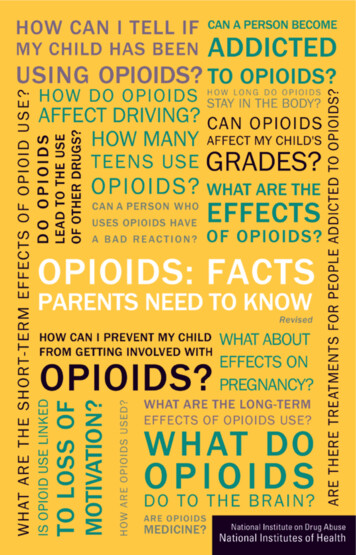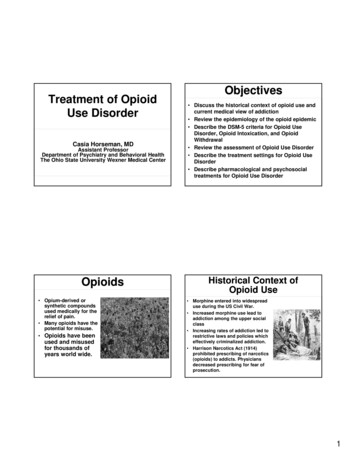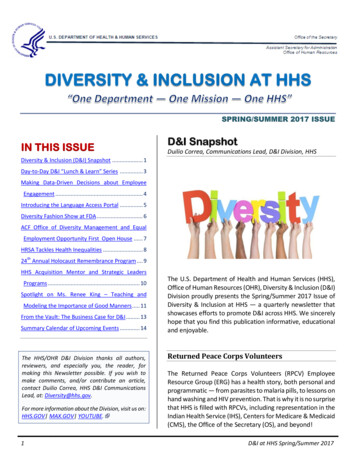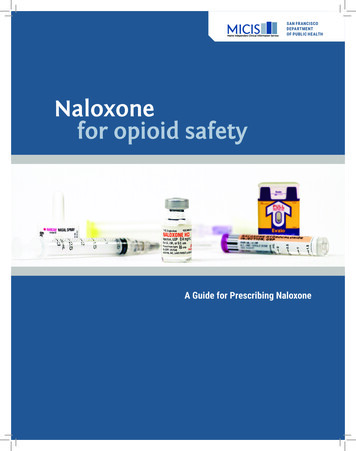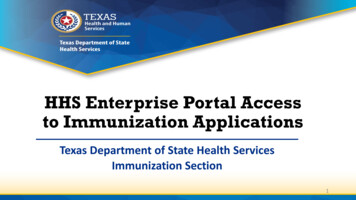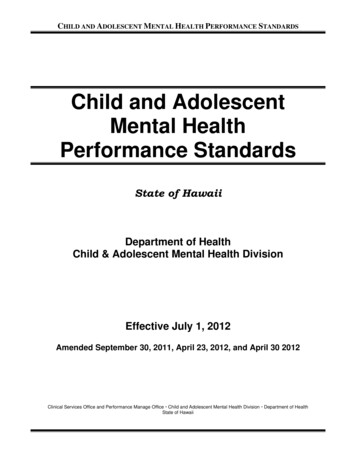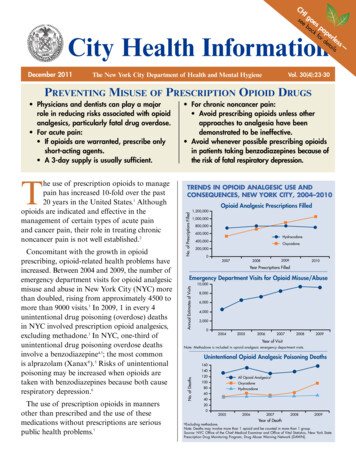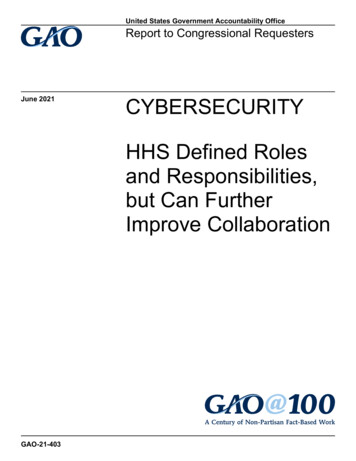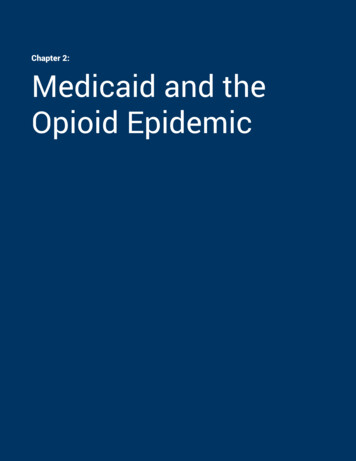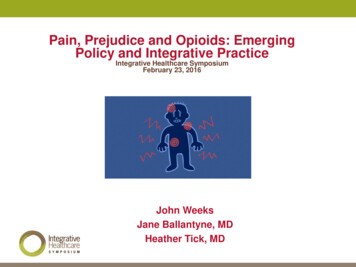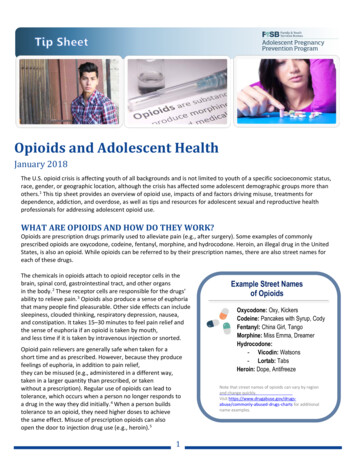
Transcription
Opioids and Adolescent HealthJanuary 2018The U.S. opioid crisis is affecting youth of all backgrounds and is not limited to youth of a specific socioeconomic status,race, gender, or geographic location, although the crisis has affected some adolescent demographic groups more thanothers.1 This tip sheet provides an overview of opioid use, impacts of and factors driving misuse, treatments fordependence, addiction, and overdose, as well as tips and resources for adolescent sexual and reproductive healthprofessionals for addressing adolescent opioid use.WHAT ARE OPIOIDS AND HOW DO THEY WORK?Opioids are prescription drugs primarily used to alleviate pain (e.g., after surgery). Some examples of commonlyprescribed opioids are oxycodone, codeine, fentanyl, morphine, and hydrocodone. Heroin, an illegal drug in the UnitedStates, is also an opioid. While opioids can be referred to by their prescription names, there are also street names foreach of these drugs.The chemicals in opioids attach to opioid receptor cells in thebrain, spinal cord, gastrointestinal tract, and other organsin the body. 2 These receptor cells are responsible for the drugs’ability to relieve pain. 3 Opioids also produce a sense of euphoriathat many people find pleasurable. Other side effects can includesleepiness, clouded thinking, respiratory depression, nausea,and constipation. It takes 15–30 minutes to feel pain relief andthe sense of euphoria if an opioid is taken by mouth,and less time if it is taken by intravenous injection or snorted.Opioid pain relievers are generally safe when taken for ashort time and as prescribed. However, because they producefeelings of euphoria, in addition to pain relief,they can be misused (e.g., administered in a different way,taken in a larger quantity than prescribed, or takenwithout a prescription). Regular use of opioids can lead totolerance, which occurs when a person no longer responds toa drug in the way they did initially. 4 When a person buildstolerance to an opioid, they need higher doses to achievethe same effect. Misuse of prescription opioids can alsoopen the door to injection drug use (e.g., heroin). 51Example Street Namesof OpioidsOxycodone: Oxy, KickersCodeine: Pancakes with Syrup, CodyFentanyl: China Girl, TangoMorphine: Miss Emma, DreamerHydrocodone:- Vicodin: Watsons- Lortab: TabsHeroin: Dope, AntifreezeNote that street names of opioids can vary by regionand change quickly.Visit ed-drugs-charts for additionalname examples.
WHO IS USING OPIOIDS?Findings from the 2016 Monitoring the Future (MTF) a study demonstrate continued declines in the use of many drugs,including opioids, among high school youth (see Figure 1). b However, the nonmedical use of prescription opioids(NMUPO) remains a significant healthFigure 1: Lifetime Prevalence of Medical Use andthreat to adolescents and adults alike.Non-Medical Use of Opioids Among 12th Grade StudentsThe MTF study estimated that 22.3%(by Race)of all U.S. high school seniors havehad some medical or nonmedical6.7%exposure to opioids. 6 Of theseHispanic5.9%students, the lifetime prevalence ofany medical use of prescription6.9%African-American4.0%opioids was 22.8% among White 12thgraders,6.9% among African22.8%WhiteAmerican 12th graders, and 6.7%16.4%among Hispanic 12th graders. The0.0%5.0%10.0%15.0%20.0%25.0%lifetime prevalence of NMUPO was16.4% among White 12th gradePrescription OpioidsNMUPOstudents, 4.0% among AfricanAmerican 12th grade students, and 5.9% among Hispanic 12th grade students. 7 By 12th grade, males surpass females inthe use of illicit drugs, including heroin, and White 12th grade students have the highest level of heroin use whencompared to African-American and Hispanic 12th grade students. 8Opioids are also a problem for youth across the nation and in the U.S. territories, regardless of location. Although theabsolute death toll related to opioid use is the greatest in big cities, like Chicago and Baltimore, misuse, overdose, anddeath are most concentrated in rural regions such as Appalachia, New England, and the Midwest. 9,10WHAT ARE SOME OF THE POSSIBLE CONSEQUENCES OF NMUPO?The misuse of opioids can have several negative health consequences, including organ damage, increased exposure toHIV and hepatitis with injectable drug use, withdrawal symptoms (e.g., restlessness, muscle and bone pain, insomnia,diarrhea, vomiting, cold flashes), and overdose that can lead to death. 11,12,c In addition, adolescents who misuse opioidsare more likely to have lower grades, be absent from school, drop out of school, associate with antisocial peer groups,and engage in sexual risk behavior compared to adolescents who do not misuse opioids. 13,14,15,d When pregnant womenuse opioids, their infants may experience withdrawal symptoms (i.e., neonatal abstinence syndrome). 16,eWHAT FACTORS ARE DRIVING OPIOID MISUSE ANDOVERDOSE?Increase in Prescriptions for Opioids. There has been consistent growth in thenumber of prescriptions written for opioids in the United States, increasing from 76million prescriptions in 1991 to 207 million prescriptions in 2013. 17 In fact, the UnitedStates accounts for 80% of the world’s prescription opioid use. 18 In addition,pharmaceutical companies have increased the marketing of drugs, including opioids,The MTF study is a nationally representative survey of high school students funded by the National Institute on Drug Abuse. To learn more aboutthe MTF study, see the full 2016 report at http://www.monitoringthefuture.org.b Figure 1 was created using MTF survey data.c See overdose death data for people aged 15–24 at erdose-data-youth-1999-2015.pdf.d Substance use and sexual risk behaviors share some common underlying factors that may predispose adolescents to these behaviors. Becausesubstance use clusters with other risk behaviors, it is important to learn whether precursors can be determined early to help identify youth who aremost at risk. More research is needed in this area.e For more information about the risks of opioid use during pregnancy, y opioid pain factsheet-a.pdf.a2
to health care providers and patients. 19 These factors partially explain the greater availability and social acceptance ofopioids. 20Lack of Understanding about Opioids. The misuse or nonmedical use of prescription drugs is greater than the use ofillicit drugs, with the exception of marijuana, among adolescents and young adults. This can be attributed toadolescents’ perception that prescription drug use is safer than illicit drugs, that these drugs are easier to access, andthat there is a lower societal stigma about misuse compared to illicit drug use. 21,22In addition, many adolescents lack education on the dangers associated with opioid misuse, believe opioids are safebecause they are prescribed by a doctor, and do not have enough information about where to get help. In one study,prescription opioid use before high school graduation was associated with a 33% increase in the risk of future opioidmisuse after high school. This association was concentrated among individuals who have little to no history of drug useand a strong disapproval of illegal drug use at baseline. 23 Additionally, individuals who misuse opioids can develop anopioid tolerance and later dependence. Opioid dependence is difficult to overcome, and withdrawal symptoms can bevery painful.Influence of Social and Psychological Factors. Adolescents often misuse opioids for the same reasons they misuse otherillicit substances (e.g., curiosity, boredom, peer pressure, wanting to get high, self-medication of physical or mental pain,lack of school connectedness, alienation, rebelliousness, history of posttraumatic stress disorder, sexual abuse,witnessing violence, and lower socioeconomic status). 24,25,26 Although adolescents from any demographic mayexperience opioid use and misuse, those in the Medicaid patient population are more likely to be prescribed opioids andfor longer periods of time. Opioid medication overdose deaths are also more common among Medicaid-eligiblepopulations. 27 Other social factors that can influence opioid misuse are lack of parental involvement, parental use ofopioids, and favorable parental attitudes toward opioid use. 28Ease of Obtaining Opioids. Opioids are relatively easy for youth to find. According to one study, adolescents aged 12–17obtained opioids for nonmedical use for free (46%) or purchased them (20%) from a friend or relative. 29 Other sourcesof opioids include legal prescriptions, drug dealers, and online. 30 Some teens (and adults) will turn to heroin because itcan be purchased on the street for a significantly lower cost than prescription opioids, especially if they build a toleranceto a prescription opioid and can no longer obtain a prescription from their doctor.Combining Opioids with Other Substances. Adolescents may mix prescription opioids with other substances (e.g.,marijuana or alcohol). 31 They may also use opioids more intensely, such as in higher doses or by snorting or injecting.Both mixing substances and intense use can lead to a higher risk of unintentional overdose, especially if opioid pills arefor modified release or extended release. f Opioids purchased on the street (including heroin) are often not as pure or ofhigher dosage, which can also lead to unintentional overdose. 32Lack of Services. There is a lack of prevention and treatment services for opioid misuse and overdose, especially foradolescents. There are not enough medication-assisted treatment facilities for opioid addiction, and those that areoperating are stretched thin, creating a treatment gap of nearly 1 million people in the United States. 33,g According toone study, 12% of opioid-addicted adults received medication for treatment, compared to less than 1% of adolescents. 34Similarly, 26% of adult heroin addicts received medication-assisted treatment, compared to 2% of heroin-addictedadolescents. 35f Thisrefers to the mechanism used in pills and capsules to dissolve a drug over time to release more slowly and steadily into the bloodstream.For more information about evidence-based treatments for adolescent opioid addiction, eating-adolescent-substance-use-disorders.g3
HOW ARE OPIOID DEPENDENCE, ADDICTION,h AND OVERDOSE TREATED? Medications for Addiction: Effective medications exist to treat opioid addiction. Agonists like methadone (whichactivate opioid receptors) and partial agonists like buprenorphine (which also activate opioid receptors but producea diminished response) can be used. 36 Both of these medications stop and prevent opioid withdrawal and reduceopioid cravings, allowing the person to focus on other aspects of recovery. Antagonists, like naltrexone, block opioidreceptors and interfere with the rewarding effects of opioids. 37Medications for Overdose: An opioid overdose can be reversed with the drug naloxone when administered rightaway. 38Therapy: Counseling and behavioral therapy are available for adolescents and their families. iPsychiatric Help: This includes screening and treatment of comorbid psychiatric diseases.WHAT CAN ADOLESCENT SEXUAL AND REPRODUCTIVE HEALTHPROFESSIONALS DO ABOUT ADOLESCENT OPIOID USE?Get Educated and Educate Others Participate in professional development training about opioid use and misuse. Develop and provide educational activities for parents, schools, and the community that specifically addressadolescent opioid use and misuse (as opposed to substance use in general). Develop, test, and promote effective messages about preventing opioid misuse in adolescent populations. Integrate messages and information about opioids into other health education efforts (e.g., sexual health, mentalhealth, fitness).Be Alert and Ready to Help Recognize the signs of opioid misuse and overdose, including changes in a young person’s relationships with familyor friends, confusion, poor concentration, avoiding eye contact, pinpoint pupils, unexplained giggling, clumsiness,lack of coordination, slow gait, drowsiness, flushing, mood changes, and changes in sleeping patterns. Know the resources and services in your community and provide referrals when appropriate. Make sure theresources in your community provide evidence-based treatment for opioid addiction, not just detox, which canresult in relapse and is risky for pregnant women. 39 Know and abide by the reporting requirements that apply to your profession. Do not stigmatize people who use or misuse drugs by shaming, ridiculing, or blaming. Doing so will alienateadolescents and discourage them from asking for help. Remember that opioid addiction is a chronic condition and should be treated as such. 40 Some people who strugglewith opioid addiction will need to be on Methadone Maintenance Therapy (MMT) for the rest of their lives to avoida relapse. It is important to destigmatize MMT by considering it a treatment for a chronic condition. 41Organize, Collaborate, and Advocate Convene and partner with adult and youth leaders (e.g., state and local governments, tribal councils, schools,universities, community-based organizations, health care organizations, treatment centers, funders, communities offaith, private businesses, police, and parents) to advocate for greater education to prevent youth opioid use andmisuse. Advocate for improved access to opioid addiction treatment for adolescents (including counseling, treatmentcenters, and treatment drugs) to address the NMUPO in your community. Advocate for the removal of barriers to clean syringe programs (for the prevention of HIV and other infections). 42 Advocate for the increased availability of the overdose-reversing drug, naloxone. If you work with youth who havesubstance use problems, obtain naloxone and get trained in its use. Advocate for more research on the associations between opioid use and adolescent sexual and reproductive health.For an explanation of the difference between dependence and addiction, see ce-between-physical-dependencei For examples of evidence-based therapeutic approaches, visit https://www.drugabuse.govh4
WHERE CAN I GET MORE INFORMATION?National Organizations National Institute on Drug Abuse (NIDA): https://www.drugabuse.gov/drugs-abuse/opioids andhttps://teens.drugabuse.gov Substance Abuse and Mental Health Services Administration (SAMHSA): https://www.samhsa.gov Centers for Disease Control and Prevention (CDC): https://www.cdc.gov/drugoverdose/opioids American Academy of Pediatrics: https://www.aap.org Community Anti-Drug Coalition of America (CADCA): http://www.preventrxabuse.org Partnership for Drug-Free Kids: es National Suicide Prevention Lifeline: 1-800-273-TALK (8255) SAMHSA’s Helpline: 1-800-662-HELP (4357) Crisis Text Line: Visit www.crisistextline.org or text “START” to 741-741Treatment Locators SAMHSA Behavioral Health Treatment Services Locator: https://findtreatment.samhsa.gov SAMHSA Opioid Treatment Program Directory: http://dpt2.samhsa.gov/treatment/directory National Council on Alcoholism and Drug Dependence: ourcesREFERENCESSubstance Abuse and Mental Health Services Administration (SAMHSA). (2009). Results from the 2008 National Surveyon Drug Use and Health: National Findings. (NSDUH Series H-36, HHS Publication No. SMA 09-4434). Rockville, MD:SAMHSA Office of Applied Studies.2America’s addiction to opioids: Heroin and prescription drug abuse, Senate, 113th Cong. (2014) (Dr. Nora D. VolkowAppearing before the Senate Caucus on International Narcotics Control).3NIDA (n.d.) How do opioids work? Retrieved from er/opioids/how-do-opioids-work on September 7, 2017.4NIDA. (2007). The neurobiology of drug addiction. Retrieved from on on September 7, 2017.5Pollini, R. A., Banta-Green, C. J., Cuevas-Mota, J., Metzner, M., Teshale, E., & Garfein, R. S. (2011). Problematic use ofprescription-type opioids prior to heroin use among young heroin injectors. Substance Abuse and Rehabilitation, 2(1),173–180.6McCabe, S. E., West, B. T., Teter, C. J., & Boyd, C. J. (2012). Medical and nonmedical use of prescription opioids amonghigh school seniors in the United States. Archives of Pediatrics and Adolescent Medicine, 166(9), 797–802.7Ibid.8Ibid.9Keyes, K. M., Cerdá, M., Brady, J. E., Havens, J. R., & Galea, S. (2014). Understanding the rural-urban differences of nonmedical prescription opioid use and abuse in the United States. American Journal of Public Health, 104(2), e52–e59.10The Economist. (March 6, 2017). America’s opioid epidemic is worsening. Retrieved 2017/03/daily-chart-3 on September 5, 2017.11The National Institute on Drug Abuse Blog Team. (n.d.). Heroin. Retrieved from https://teens.drugabuse.gov/drugfacts/heroin on September 5, 2017.12Ibid.13Paolini, A. C. (2016). Heroin usage: Impact on student performance and truancy among high school students. Journalof Drug Abuse, 2, 1–7.15
14Ibid.Division of Adolescent and School Health, Centers for Disease Control and Prevention. (n.d.). Substance use and sexualrisk behaviors among teens. Retrieved from ndex.htm on April14, 2017.16Behavioral Health Coordinating Committee Prescription Drug Abuse Subcommittee U.S. Department of Health andHuman Services. (2013). Addressing prescription drug abuse in the United States: current activities and futureopportunities. Washington DC.17America’s Addiction to opioids: Heroin and prescription drug abuse, Senate, 113th Cong. (2014) (Dr. Nora D. VolkowAppearing before the Senate Caucus on International Narcotics Control).18Rudd, R. A., Seth, P., David, F., & Scholl, L. (2016). Increases in drug and opioid-involved overdose deaths — UnitedStates, 2010–2015. MMWR Morbidity and Mortality Weekly Report, 65(50-51), 1445–1452. Washington D.C.: Centerfor Disease Control.19America’s Addiction to opioids: Heroin and prescription drug abuse, Senate, 113th Cong. (2014) (Dr. Nora D. VolkowAppearing before the Senate Caucus on International Narcotics Control).20Miech, R., Johnston, L., O’Malley, P. M., Keyes, K. M., & Heard, K. (2015). Prescription opioids in adolescent and futureopioid misuse. Pediatrics, 136(5), e1–e9.21Friedman, R. A. (2006). The changing face of teenage drug abuse: The trend toward prescription drugs. The NewEngland Journal of Medicine, 354(14), 1448–1450.22Manchikanti, L. (2006). Prescription drug abuse: What is being done to address this new drug epidemic? Testimonybefore the subcommittee on criminal justice, drug policy and human resources. Pain Physician Journal, 9(4), 287–321.23Miech, R., Johnston, L., O’Malley, P. M., Keyes, K. M., & Heard, K. (2015). Prescription opioids in adolescent and futureopioid misuse. Pediatrics, 136(5), e1-e9.24Miech, R. A., Johnston, L. D., O’Malley, P. M., Bachman, J. G., Schulenberg, J. E., & Patrick, M. E. (2017). Monitoring theFuture National Survey results on drug use (1975-2016): 2016 Volume 1, secondary school students. Ann Arbor:Institute for Social Research, The University of Michigan.25Paolini, A. C. Heroin usage: Impact on student performance and truancy among high school students. 2016. Journal ofDrug Abuse, 2(1:02): 1–7.26Miech, R. A., Johnston, L. D., O’Malley, P. M., Bachman, J. G., Schulenberg, J. E., & Patrick, M. E. (2017). Monitoring theFuture National survey results on drug use (1975-2016): 2016 Volume 1, secondary school students. Ann Arbor:Institute for Social Research, The University of Michigan.27Behavioral Health Coordinating Committee Prescription Drug Abuse Subcommittee U.S. Department of Health andHuman Services. (2013). Addressing prescription drug abuse in the United States: Current Activities and futureopportunities. Washington DC.28Miech, R., Johnston, L., O’Malley, P. M., Keyes, K. M., & Heard, K. (2015). Prescription opioids in adolescent and futureopioid misuse. Pediatrics, 136(5), e1-e9.29Volkow, N. D. (2009). Teen prescription drug abuse: A major health concern. Tennessee Medicine, 102(4), 28–29.30Ibid.31NIDA. (2013). Teens Mix Prescription Opioids with Other Substances. Retrieved pioids-othersubstances on October 17, 2017.32NIDA. (2017). Heroin. Retrieved from eroin on October 17, 2017.33Jones, C. M., Campopiano, M., Baldwin, G., & McCance-Katz, E. (2015). National and state treatment need andcapacity for opioid agonist medication-assisted treatment. American Journal of Public Health, 105(8), e55-e63.156
Harding, A. (March 13, 2017). Hardly any teens receive effective treatment for opioid addiction. Retrieved tion us 58c6dab8e4b081a56dee2e83 on October 17, 2017.35Ibid.36America’s Addiction to Opioids: Heroin and Prescription Drug Abuse, Senate, 113th Cong. (2014) (Dr. Nora D. VolkowAppearing before the Senate Caucus on International Narcotics Control).37Ibid.38National Institute on Drug Abuse. (n.d.). Opioids. Retrieved from https://www.drugabuse.gov/drugs-abuse/opioids onSeptember 5, 2017.39Unger, A., Metz, V., & Fischer, G. (2012). Opioid dependent and pregnant: What are the best options for mothers andneonates? Obstetrics and Gynecology International, 2012, Article ID 195954.40American Society of Addiction Medicine. (2014). Treating opioid addiction as a chronic disease. Retrieved cacy/cmm-fact-sheet---11-07-14.pdf on September 10, 2017.41Rich, J. D., Boutwell, A. E., Shield, D. C., Key, R. G., McKenzie, M., Clarke, J. G., & Friedmann, P. D. (2005). Attitudes andpractices regarding the use of methadone in U.S. state and federal prisons. Journal of Urban Health, 82(3), 411–419.42National Institute on Drug Abuse. (2016). Syringe-exchange programs are part of effective HIV prevention. Retrievedfrom hiv-prevention on September 10, 2017.34This tip sheet was developed by Healthy Teen Network and RTI International under contract #HHSP233200951WC Task 4with the U.S. Department of Health and Human Services, Administration on Children, Youth and Families, Family andYouth Services Bureau.Suggested Citation: Rolleri, L. A., & Garrido, M. (2018). Opioids and adolescent health. Washington, DC: Administrationon Children, Youth and Families, Family and Youth Services Bureau.7
like methadone (which activate opioid receptors) and . partial agonists. like buprenorphine (which also activate opioid receptors but produce a diminished response) can be used. 36. Both of these medications stop and prevent opioid withdrawal and reduce opioid cravings, allowing the person to focus on other aspects of recovery. Antagonists,
